|
Blicke in die Urwelt und die Geschichte des Lebens an der Erboberfläche.
Neuwied & Leipzig, J.H. Heuser'sche Verlagsbuchhandlung, um 1900. 8°, 99 S., Bezahlung per PayPal möglich, we accept PayPal, Regalspuren am Fußschnitt, Einband ger. beschabt und ger. bestoßen und eingeschmutzt mit kl. Abrissen, altersbedingte Bräunungen, Gebr.sp., Interimsbindung
Bookseller reference : 30140
|
|
|
Charles Darwin. Gedenkschrift zur Jahrhundertfeier seiner Geburt. Herausgegeben von W. Bölsche u.a.
Stuttgart: Franckh. 1909.
Bookseller reference : 174011
|
|
|
Charles Darwin. Sein Leben, dargestellt in einem autobiographischen Capitel und in einer ausgewählten Reihe seiner veröffentlichten Briefe. Hrsg. von seinem Sohne F. Darwin. Autor. dt. Ausg. Aus dem Engl. übers. von J. V. Carus.
Stgt., Schweizerbart 1893. VI, 386 S. Mit 1 Porträt-Taf. u. 1 Handschriften-Faksimile. Original-Kartonband
Bookseller reference : 186231-1

|
|
|
Daheim XXII. Jahrgang
Verlag der Daheim Expedition in Leipzig. Bielefeld Velhagen u. Klasing, 1865. 772 Seiten. mit zahlreichen Illustrationen Originalhalbleinen. 29 cm
Bookseller reference : 266902

|
|
|
Darwin - seine Bedeutung im Ringen um Weltanschauung und Lebenswert. 6 Aufsätze. (Hrsg.: Max Apel).
Berlin - Schöneberg, Buchverlag der "Hilfe", 1909. 8° (19 x 12,5 cm). 123 S., 2 Blatt. Typographisch gestalteter Original-Karton mit typographisch gestalteten OUmschlag. (=Moderne Philosophie; 4).
Bookseller reference : 7925AB
|
|
|
Darwin - seine Bedeutung im Ringen um Weltanschauung und Lebenswert. 6 Aufsätze. (Hrsg.: Max Apel).
Leipzig, F.Meiner, 1914. 8° (19 x 12,5 cm). 123 S., 2 Blatt. Typographisch gestalteter Original-Karton. (=Moderne Philosophie; 4).
Bookseller reference : 7919AB
|
|
|
Darwin für Kinder und Erwachsene. Die ungeheure Verschiedenartigkeit der Pflanzen und Tiere. Ausgewählt von Volker Mosbrugger.
Frankfurt/M - Leipzig, Insel Verlag, (2008). 8° (22 x 13,5 cm). 115 (3) S. mit ganzseitigen farbigen Illustrationen von Hans Traxler. Original-Halbleinenband mit farbig illustriertem Vorderdeckel.
Bookseller reference : 4617AB
|
|
|
Darwin. - [Postcard, 1904]. -
(1904 or prior to 1904). Postcard, 13,5 x 9 cm. [2 Warenabbildungen]
Bookseller reference : 99634HB

|
|
|
Darwin. Seine Bedeutung im Ringen um Weltanschauung u. Lebenswert. 6 Aufsätze v. W. Bölsche, B. Wille u.a.
Berlin, Buch d. Hilfe, 1909. 123 S. Tekt. a. Tit. (Moderne Philosophie 4).
Bookseller reference : 809200
|
|
|
L'ILLUSTRAZIONE ITALIANA. 30 Aprile 1882. Anno IX - N. 18.
In-4, brossura. Qualche residuo di colla al dorso, peraltro ben conservato. In questo numero: “Il naturalista Carlo Darwin”.
|
|
|
LA TEORIA DELL'EVOLUZIONE COME INTRODUZIONE ALLA LETTERATURA DELLE OPERE DEL DARWIN E DE SUOI SEGUACI PER GIOVANNI CANESTRINI SECONDA EDIZIONE RIVEDUTA ED AMPLIATA DALL'AUTORE
In-8 (Cm 27,5 x 19), pp. 258-3, brossura editoriale. Brunitura del dorso con piccola mancanza. Intonso salvo poche pagine. - MOLTO BUONO

|
|
|
LE JOURNAL DES VOYAGES-N°14-6 AOUT 1925
EN COUVERTURE "LA MARINE FRANCAISE"/VISITE DU PRESIDENT DE LA REPUBLIQUE SUR BATIMENT-LE PAYS OU REGNE L'AGE D'OR/DARWIN/2P/3 PHOTOS-LE GRAND PRIX DE L'ACF/2P/4 PHOTOS/ASCARI/DELAGE-COMMENT L'HOMME DESCEND DANS LA MER/2P/3 PHOTOS/SCAPHANDRIER/ARTICLE DE MARCEL HEGELBACHER-LA TSF EXPLIQUEE/2P
Bookseller reference : ABE-3012389330
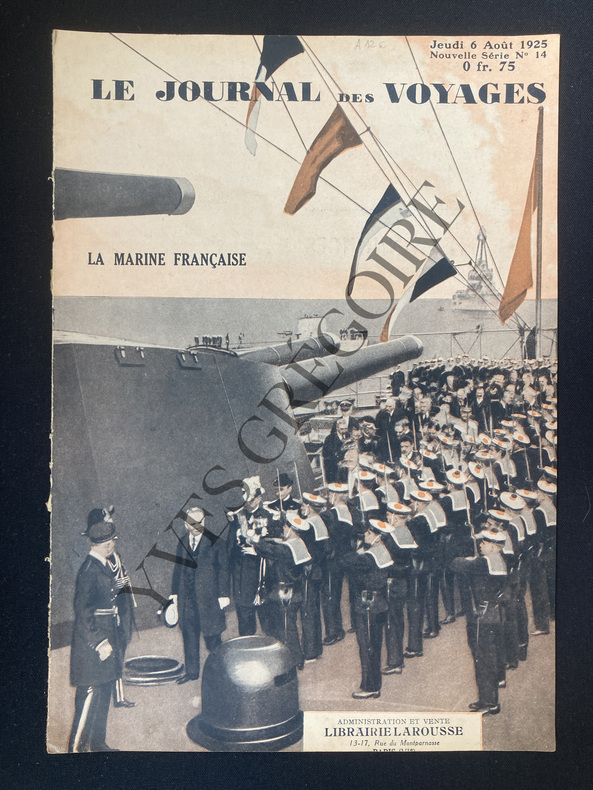
|
|
|
Leben und Briefe von Charles Darwin mit einem seine Autobiographie enthaltenden Capitel., Hg.: Francis Darwin. Bd 2 (von 3).
Stuttgart: Schweizerbart 1887. 383 S., 2 Taf. mod. Ln. *fachgerechter neuer Einband, schönes Expl.*.
Bookseller reference : 277630
|
|
|
Leben und Briefe von Charles Darwin mit einem seine Autobiographie enthaltenden Capitel., Hg.: Francis Darwin. Bd 3 (von 3).
Stuttgart: Schweizerbart 1887. IV, 402 S., 1 Taf. mod. Ln. *fachgerechter neuer Einband, schönes Expl.*.
Bookseller reference : 277631
|
|
|
Mr. C.R. Darwin, Author of "The Origin of Species". - [Wood engraving]. -
1871. 1 leaf, 41 x 29 cm with a full page wood engraving (30 x 24 cm). [2 Warenabbildungen]
Bookseller reference : 99697HB

|
|
|
The Darwin Reader. Second edition. Edited by Mark Ridley. (Reprinted).
New York: Norton. (1987).
Bookseller reference : 179283 ISBN : 393969673
|
|
|
"DARVIN, CHARLZ. [CHARLES DARWIN].
Proizkhodutu na vidovetie posriedstvom estestven podbor. [i.e. Bulgarian ""Origin of Species"" + ""Autobiography""]. Part 1 (of 2). - [FIRST BULGARIAN TRANSLATION OF DARWIN'S ORIGIN OF SPECIES]
Vidin, Pechatnitsa na Diukmedzhiev, 1905. 8vo. Uncut, unopened, in the original printed wrappers. The present volume includes includes ""Autobiography"" and first half of the ""Origin"". The second half was published shortly after. Spine lacking upper 5 cm and front wrapper with several nicks. Internally very fine and clean. (Autobiography:) 67, (2), [Origin of Speicies:] 236 pp. + frontiespiece of Darwin. Genealogical tree included in the pagination on p. 133.
Bookseller reference : 56932
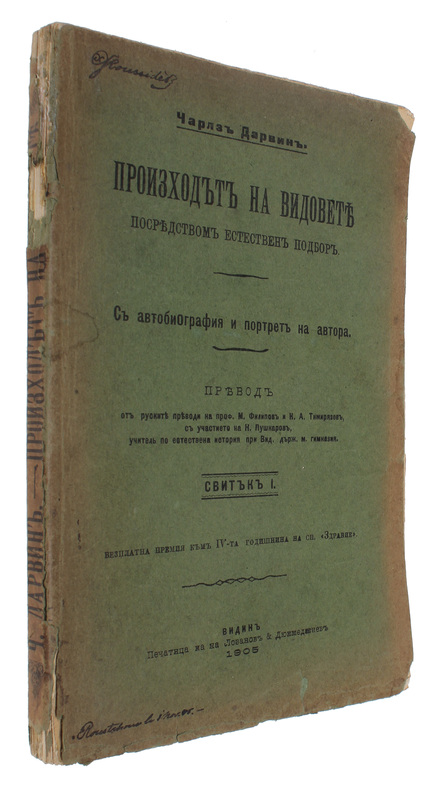
|
|
|
"DARVIN, CH´ARLZ. [CHARLES DARWIN]
Tesakneri tsagumê. t´argmanut´yune anglerenits´, rusereni ev neratsakan hodvatse K.A. Timiryazevi. [Armenian - i.e. ""Origin of Species"". Translated by K. A. Timiryazev]. - [RARE SECOND ARMENIAN TRANSLATION OF 'ORIGIN OF SPECIES']
Erevan, Hayastani Petakan Hratarakch'ut'yun, 1963. Royal8vo. In publisher's full green cloth with gilt lettering to spine and front board. Light wear to extremities, primarily affecting spine. Inner font hinge split, otherwise a fine and clean copy. 591, (1) pp. + 2 plates.
Bookseller reference : 61618

|
|
|
"DARWIN, C.
Fècondation croisèe et directe dans le règne vegètal (i.e. ""The Effects of Cross and Self-Fertilisation in the Vegetable Kingdom""). - [THE RARE FIRST FRENCH TRANSLATION]
Paris, C. Reinwald et Cie, 1877. 8vo. Uncut, unopened in the original publisher's embossed full green cloth with gilt lettering to spine. Small red label pasted on to top left corner of inner front board. Light brownspots throughout. XV, (1), 496, (2) pp.
Bookseller reference : 50988
|
|
|
"DARWIN, C. [CHARLES].
I movimenti e le abitudini delle piante rampicanti. Traduzione italiana col consenso dell'autore per cura di Giovanni Canestrini.
Torino, Unione Tipografico-Editrice, 1878. Large8vo. In recent cardboard wrappers. Occassional light brownspotting, especially to the first and last few leaves. Otherwise fine. 127 pp.
Bookseller reference : 53228
|
|
|
"DARWIN, C. R.
[Memorial to Gladstone] (+) Bree on Darwinism.
London and New York, Macmillan and Co., 1872. Royal8vo. In publisher's original red embossed cloth. In ""Nature. A Weekly Illustrated Journal of Science"", Vol. 6, May-October 1872. Stamp to title-page and p. 1 and ex-libris pasted on to pasted down front end-paper. Binding with wear and light soiling, spine loose and missing part of cloth to upper part.. Internally fine and clean. Darwin's paper (co-author): 211-216" P. 279. [Entire volume: XII, 548 pp].
Bookseller reference : 60122
|
|
|
"DARWIN, C. R.
A new view of Darwinism.
London and New York, Macmillan and Co., 1871. Royal8vo. In publisher's original red embossed cloth. In ""Nature. A Weekly Illustrated Journal of Science"", Vol. 4, April-October 1871. Stamp to title-page and p. 1 and ex-libris pasted on to pasted down front end-paper. Binding with wear and light soiling, spine partly detached with a 7 cm long tear to rear hindge. Internally fine and clean. Darwin's paper: Pp.180-181. [Entire volume: XII, 520 pp].
Bookseller reference : 60108
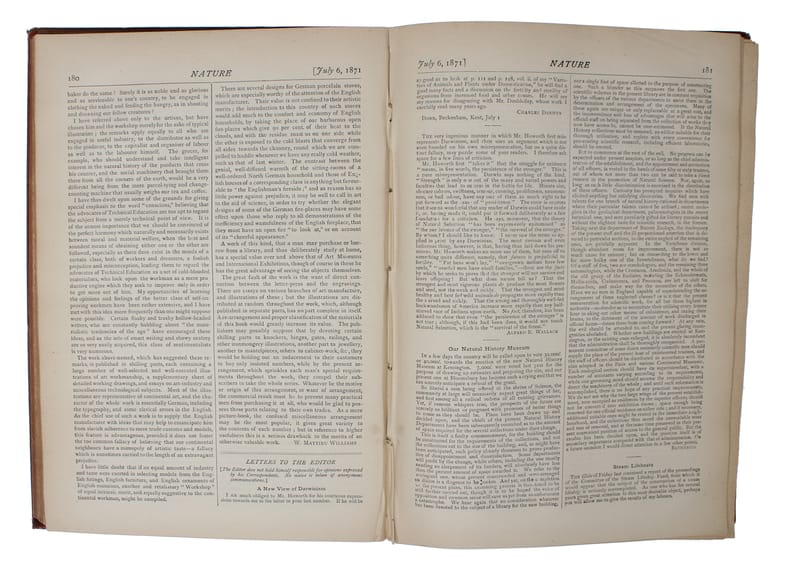
|
|
|
"DARWIN, C. R.
Flowers of the primrose destroyed by birds.
London and New York, Macmillan and Co., 1874. Royal8vo. In a bit later full green cloth. In ""Nature. A Weekly Illustrated Journal of Science"", Vol. 10, May 1874 - October 1874. Stamp to title-page and ex-libris pasted on to pasted down front end-paper. Stamps to front free end paper. Traces from book block having been bended. Darwin's paper: Pp. 24-25. [Entire volume: XI, (1), 534 pp].
Bookseller reference : 60115
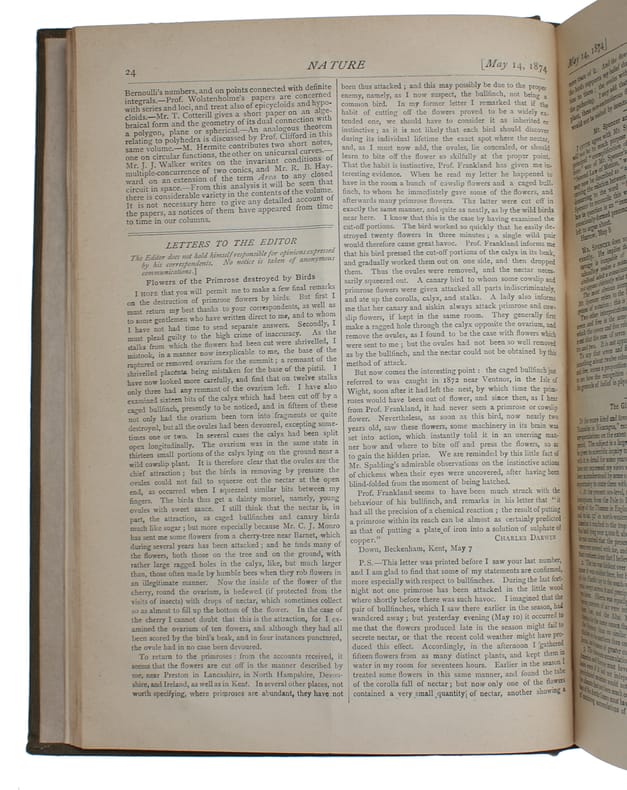
|
|
|
"DARWIN, C. R.
Pangenesis. - [DARWIN'S FERENSE OF HIS PANGENESIS-THEORY.]
London and New York, Macmillan and Co., 1871. Royal8vo. In publisher's original red embossed cloth. In ""Nature. A Weekly Illustrated Journal of Science"", Vol. 3, November 1870 - April 1871. Stamp to title-page and ex-libris pasted on to pasted down front end-paper. Binding with considerable wear"" spine partly disintegrated and front board bended vertically, but bookblock firmly attached. Internally fine and clean. Darwin's paper: Pp. 502-503. [Entire volume: XII, 520 pp].
Bookseller reference : 60107
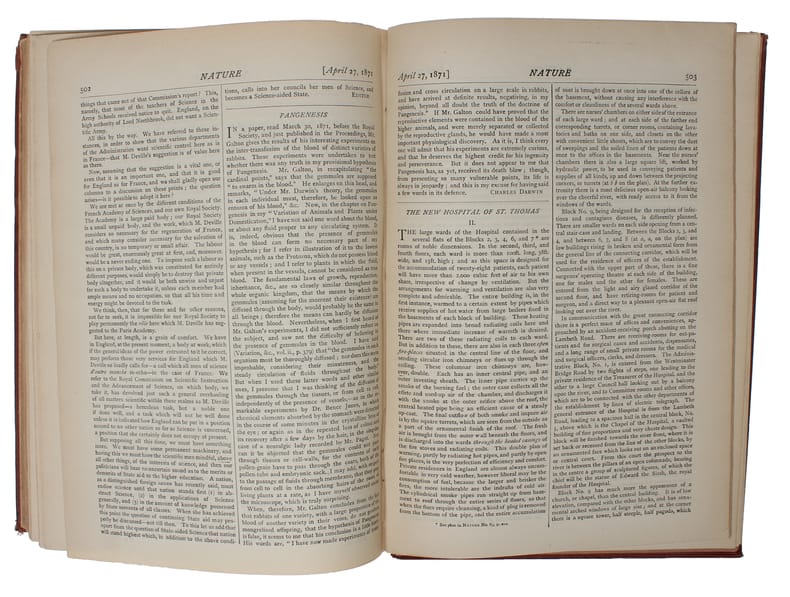
|
|
|
"DARWIN, C. R. (+) DARWIN, G. H.
Habits of ants (+) On the males and complemental males of certain cirripedes, and on rudimentary structures [C. R. Darwin] (+) Variations of organs [G. H. Darwin].
(London and New York, Macmillan and Co., 1873). Royal8vo. In contemporary cloth. In ""Nature. A Weekly Illustrated Journal of Science"", Vol. 8, July 1873 - October 1873. Extremities with wear and end papers brownspottet. Internally fine and clean. C. R. Darwin's papers: P. 244" Pp. 431-432. G. H. Darwin's paper: p. 505 . [Entire volume: Pp. 237-562].
Bookseller reference : 60116
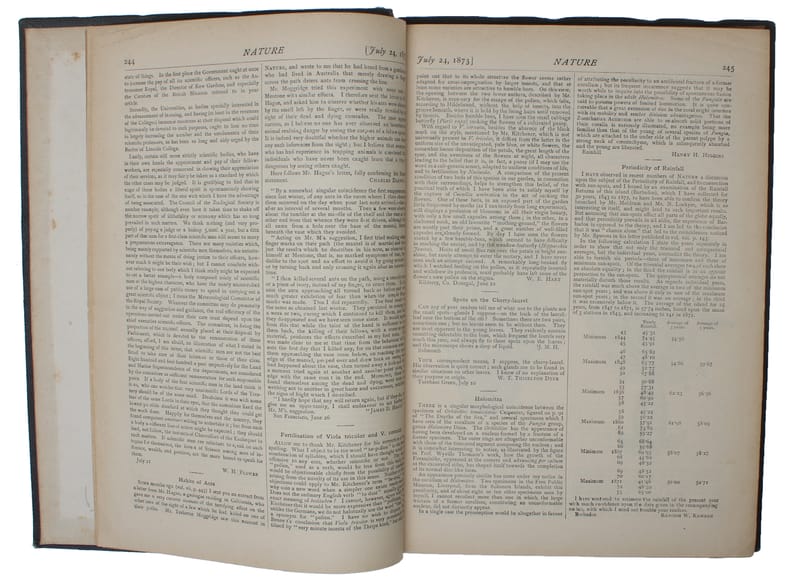
|
|
|
"DARWIN, CARLO (CHARLES).
Sull'Origine delle Specie per Elezione Naturale ovvero Conservazione delle Razze perfezionate nella Lotto per L'Esistenza. Prima Traduzione Italiana col Consenso dell' Autore per Cura di G. Canestrini e L. Salimbeni. - [FIRST ITALIAN TRANSLATION OF DARWIN'S ""ORIGIN OF SPECIES""]
Modena, Nicola Zanichelli e. Soci, 1864. 8vo. In contemporary half calf with four raised bands and gilt lettering to spine. Reinforced in inner margins and plate with waterstains to lower margin. An unusually fine and well preserved copy, internally as well as externally. XV, 403 pp + 1 plate.
Bookseller reference : 55760
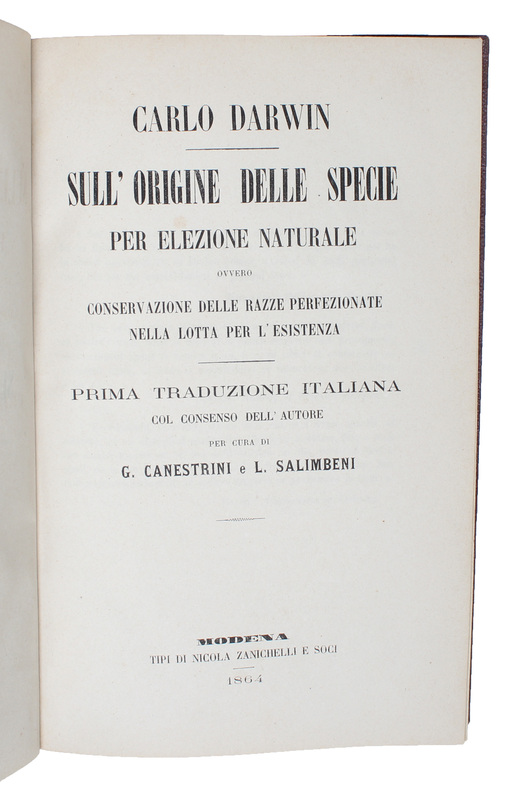
|
|
|
"DARWIN, CARLO [CHARLES].
Sulla struttura e distribuzione dei banchi di corallo e delle isole madreporiche. [i.e. English ""The structure and distribution of coral reefs""].
Torino, Unione Tipografico-Editrice, 1888. 8vo. In comtenporary half vellum with embossed title to spine. First quire partly detached. Occassional light brownspotting throughout. (2), 210, (4) pp. + 3 floded plates and 1 frontiespiece. This
Bookseller reference : 53223
|
|
|
"DARWIN, CARLO [CHARLES].
Viaggio di un naturalista Intorno al Mondo. [i.e. English ""Journal of Researches"" or ""Voyage of the Beagle""]. - [FIRST ITALIAN TRANSLATION OF DARWIN'S 'JOURNAL OF RESEARCHES']
Torino, Tipografico-Editrice Torinese, (1872). Large8vo. In publisher's original full green cloth. Embossed title with gilt lettering to spine and front board. Corners of binding bumped and lower part of back hindge with a small tear. An overall very fine and clean copy. (2), 464 pp.
Bookseller reference : 53225
|
|
|
"DARWIN, CARLOS.
Diario del Viaje de un Naturalista Alrededor del Mundo. 2 vols. - [FIRST COMPLETE SPANISH TRANSLATION OF DARWIN'S ""JOURNAL OF RESEARCHES""]
Madrid, Calpe, (1921 & 1922) 8vo. Bound in one half calf binding with four raised bands. Spine with wear, otherwise a fine copy. X, (6), 361, VIII, 359, (3) pp. + 1 folded map.
Bookseller reference : 53616
|
|
|
"DARWIN, CH. (CHARLES).
De L'Origine des Espèces ou des Lois du Progrès chez les Étres organisés par Ch. Darwin. Traduit en francais sur le troisieme Édition avec l'autorisation de l'Auteur par Mlle Clémence-Auguste Royer. Avec une Preface et des Notes du Traducteur. - [FIRST FRENCH EDITION OF THE ""ORIGIN OF SPECIES""]
Paris, Guillaumin et Cie, Victor Masson et Fils, 1862. 8vo. In contemporary half calf with gilt title to spine. Very light minor brownspotting to a few pages. Previous owner's name to half title. A fine copy. LXIV (incl. half-title), I-XXIII + (24-) 712. pp. and 1 folded plate (between pp.160 a. 161). Fully complete.
Bookseller reference : 52388
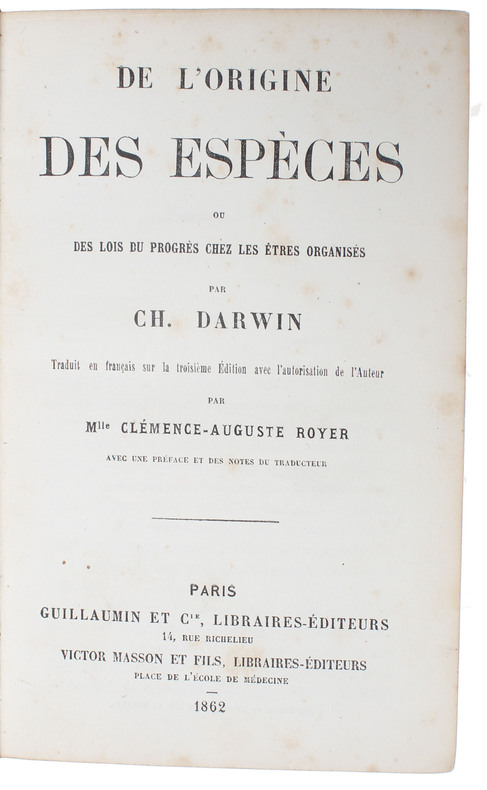
|
|
|
"DARWIN, CH. (CHARLES).
De L'Origine des Espèces ou des Lois du Progrès chez les Étres organisés par Ch. Darwin. Traduit en francais sur le troisieme Édition avec l'autorisation de l'Auteur par Mlle Clémence-Auguste Royer. Avec une Preface et des Notes du Traducteur. - [FIRST FRENCH EDITION OF THE ""ORIGIN""]
Paris, Guillaumin et Cie, Victor Masson et Fils, 1862. 8vo. Bound uncut and with the original printed front wrapper (expertly restored) in a very fine later half morocco binding with four raised bands and gilt title to spine. Very light minor brownspotting to a few pages. An exceptionally nice, clean, and attractive copy. LXIV (incl. half-title), I-XXIII + (24-) 712. pp. and 1 folded plate (between pp.160 a. 161). Fully complete.
Bookseller reference : 50871
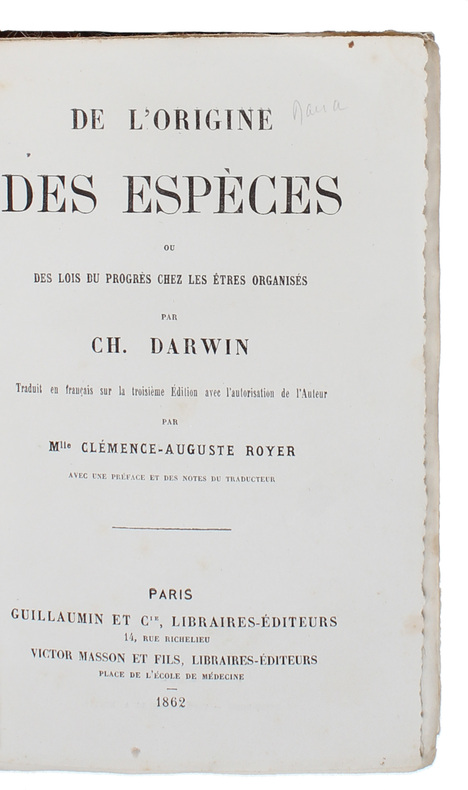
|
|
|
"DARWIN, CH. (CHARLES).
De L'Origine des Espèces ou des Lois du Progrès chez les Étres organisés par Ch. Darwin. Traduit en francais sur le troisieme Édition avec l'autorisation de l'Auteur par Mlle Clémence-Auguste Royer. Avec une Preface et des Notes du Traducteur. - [FIRST FRENCH EDITION OF THE ""ORIGIN""]
Paris, Guillaumin et Cie, Victor Masson et Fils, 1862. 8vo. Bound partly uncut with the original wrappers in a very nice later full calf pastiche binding with four raised band and richly gilt spine. Gilt boarders to boards. Small repair to upper right corner of title-page, not affecting text. An exceptionally fine and clean copy. LXIV (incl. half-title), I-XXIII + (24-) 712. pp. and 1 folded plate (between pp.160 a. 161).
Bookseller reference : 55642
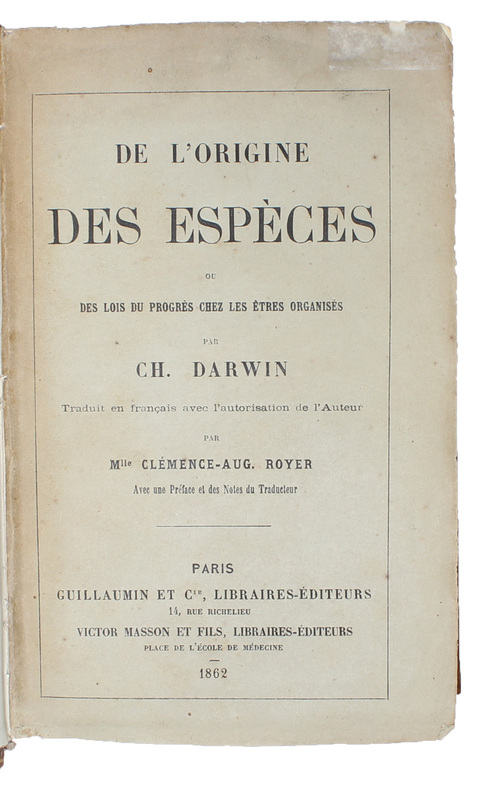
|
|
|
"DARWIN, CHARLES
Usonogie raki (i.e. 'Living Cirripedia') (+) Proishozhdenie vidov putem estestvennogo otbora... (i.e. 'On the tendency of species to form varieties') (+)Razlichnye formy tsvetov u rastenii odnogo i togo zhe vida (i.e. 'The Different Forms... - [SEVEN FIRST RUSSIAN TRANSLATIONS OF DARWIN'S SHORTER WORKS]
Moscow, Academy of Science, 1935-1959. Royal8vo. In 9 uniform full cloth bindings (albeit with slightly different colours, as published). All volumes with Darwin's signature ""Ch. Darwin"" embossed in gold to lower right corner of front board. All nine volumes with wear to spines. All nine volumes internally fine and clean (no stamps or brownspotting). XLVII, (1), 604, (4) pp. + 3 folded maps.: 682, (2) pp. + 3 folded maps: X, (2), 831, (1) pp. + 1 folded map.: 883, (1) pp.: 1040 pp. + 1 folded plate.: 696 pp.: 650 pp.: 543, (1) pp.: LVI, 734, (1) pp. The following being the collation of the papers which represent the first Russian translation of the given paper:[Geologija, Eskavajra, Tjlena Korolevskogo obschestva (i.e. 'Manual of Scientific Enquiry']: Vol. 2: Pp. 613-637[Usonogie raki (i.e. 'Living Cirripedia')]: Vol. 2: Pp. 37-87[Lectsii evolutsionnoi teorii (i.e. 'Studies in the theory of descent')]: Vol. 3: p. 755.[Proishozhdenie vidov putem estestvennogo otbora... (i.e. 'On the tendency of species to form varieties')]: Pp. 239-255.[Razlichnye formy tsvetov u rastenii odnogo i togo zhe vida (i.e. 'The Different Forms of Flowers on Plants of the Same Species')]: Vol. 7: Pp. 31-251.[Oplodotvorenie tsvetov (i.e. 'Fertilisation of flowers (Hermann Müller)']. Vol. 6: Pp. 652-654.[Zhizn Erazma Darvina (i.e. 'The Life of Erasmus Darwin')]. Vol. 9: Pp. 251-309.
Bookseller reference : 53497
|
|
|
"DARWIN, CHARLES (+) ASAJIRO OKA [translated and revised by).
Shu no Kigen: Seizon Kyoso Tekisha Seizon no Genri (i.e. English: ""Origin of Species""]. - [THE MOST INFLUENTIAL JAPANESE TRANSLATION OF 'ORIGIN OF SPECIES']
Tokyo, Tokyo Kaiseikan, Meiji 38 [1905]. 8vo. In the original full bloth cloth with gilt letteing (in both Japanese and Latin characters). Light occassional brownspotting, otherwise a fine copy. 4, 894, 28, 12 pp. + frontispiece and folded plate with genealogical tree.
Bookseller reference : 55802
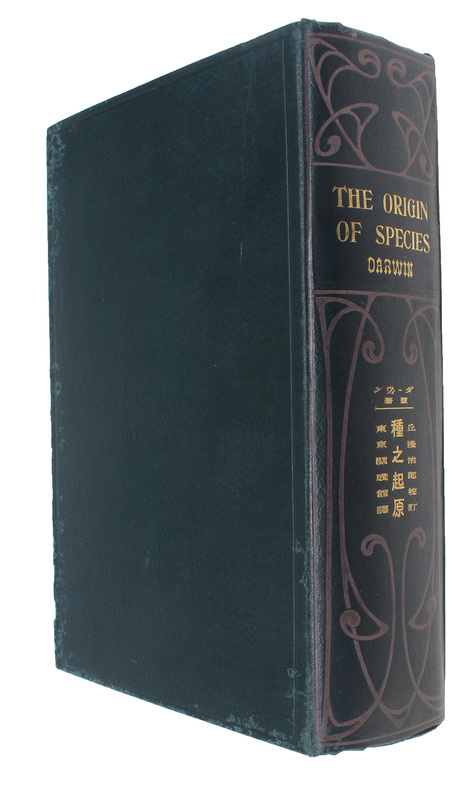
|
|
|
"DARWIN, CHARLES.
A fajok eredete a természeti kiválás útján vagyis az elonyös válfajok fenmaradása a létérti küzdelemben. [Hungarian - i.e. On the Origin of Species... Translated by Dapsy László and revised by Margó Tivadar]. 2 vols. - [THE FIRST HUNGARIAN ""ORIGIN OF SPECIES""]
Budapest, Kiadja a Természettudományi Társulat [Academy of Sciences], 1873 & 1874. 8vo. In two contemporary embossed full cloth bindings with gilt letter- and numbering to spine. Bindings with light wear, primarily affecting hindges. Previous owner's stamp to half title and title page in both volumes. Light occassional brownspotting, primarily affecting first and last leaves. An overall nice copy. XVI, (2), 303, (1)"" VII, (1), 361, (1) pp. + 1 leaf of Advertisement + 2 plates (A frontiespiece of Darwin and one listing the evolution of the different generations).
Bookseller reference : 60158
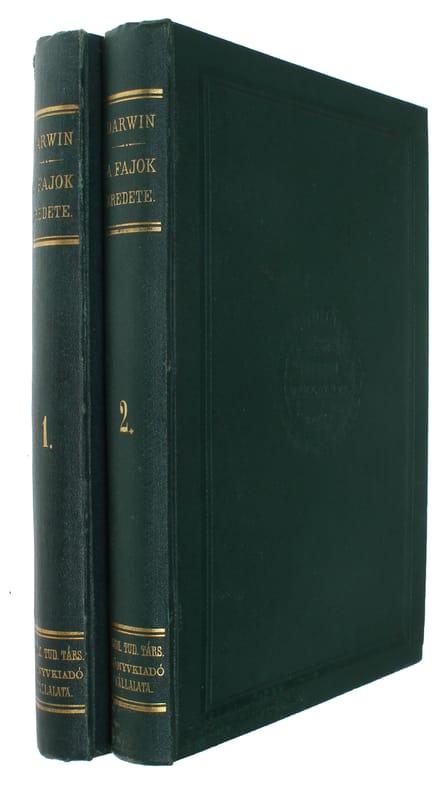
|
|
|
"DARWIN, CHARLES.
Az Ember Származàsa és az Ivari Kiválás [i.e. Hungarian: ""The Descent of Man.""]. [Translated by:] Török Aurei és Entz Géza. 2 vols. - [FIRST HUNGARIAN TRANSLATION OF DARWIN'S ""THE DESCENT OF MAN""]
Budapest, Kiadja A. K. M., 1884. 8vo. In the publisher's original two embossed full red cloth bindings with gilt lettering to spine. Small vague stamp to both half-titles. Hindges loose on volume i. A fine fine and clean copy. LXXI, (1), 542 pp."" VII, 5, 436 pp.
Bookseller reference : 53520
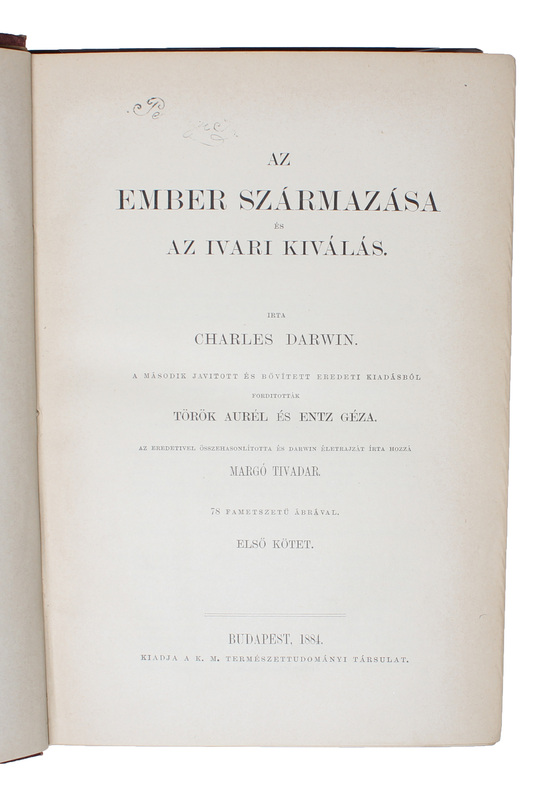
|
|
|
"DARWIN, CHARLES.
Brief Descriptions of several Terrestrial Planariae, and of some remarkable Marine Species, with an Account of their Habits. - [DARWIN’S FIRST PUBLICATION ON TAXONOMY]
London, Taylor and Francis, 1844. 8vo. In a nice later half morocco binding with five raised bands and gilt lettering to spine. Blind stamped to upper outer corner of first leaf of table of contents. In ""The Annals and Magazine of Natural History"", volume 14. A very fine and clean copy. [Darwin's paper] pp. pp. 241-251.. [Entire volume:] vii, [1] - 472 + 12 plates.
Bookseller reference : 56991
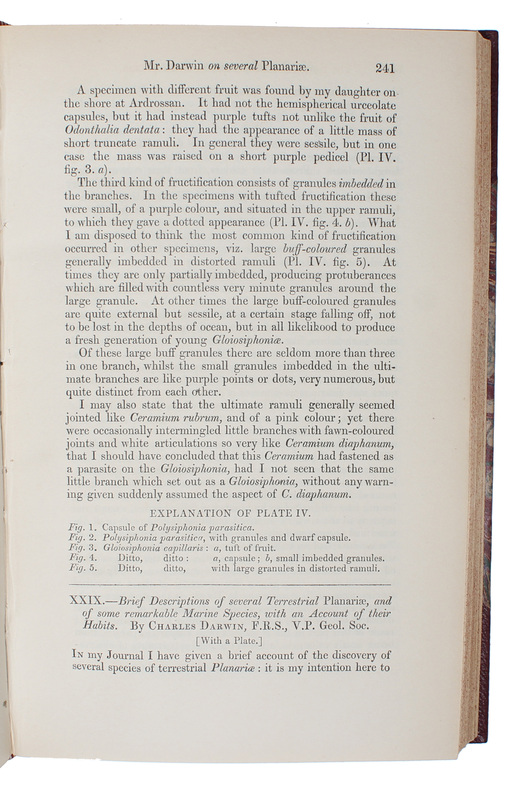
|
|
|
"DARWIN, CHARLES.
Briefe von Darwin. Mit Erinnerungen und Erlaeuterungen. (i.e. English ""Letters on Geology""). - [RARE FIRST TRANSLATION OF DARWIN'S FIRST PUBLISHED WORK]
Berlin, Gebrüder Paetel, 1891. Large8vo. In a nice contemporary half calf binding with 5 raised bands and gilt lettering to spine. In ""Deutsche Rundschau"", Band 67, 1891. Green leather title-label and red leather tome-label to spine, Small paper label pasted on to top left corner of front board. Two stamps to first leaf and one stamp to P. 476. Light wear to extremities, internally very fine and clean. Pp. 357-390. [Entire volume: IV, 480 pp.]
Bookseller reference : 53191
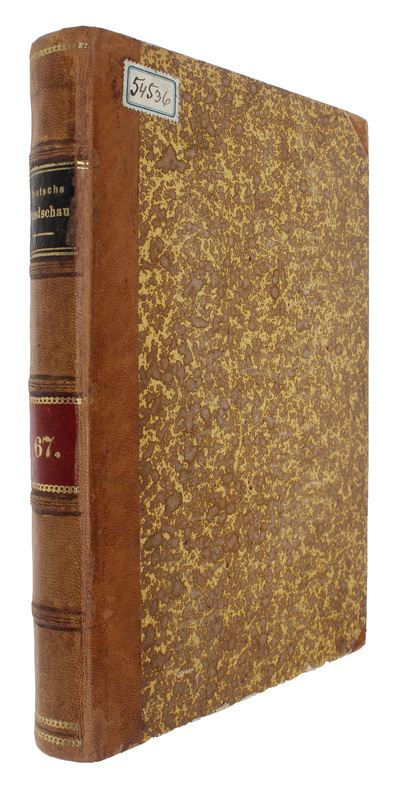
|
|
|
"DARWIN, CHARLES.
De La Variation des animaux et des plantes sous l' action de la domestication. 2 vols. [i.e. French: ""The Variation of Animals and Plants under Domestication""].
Paris, C. Reinwald, 1868 8vo. 2 volumes, both uncut (and volume 2 unopened) in publisher's green embossed full cloth with gilt lettering to spines. Light wear to capitals. Previous owner's name to half titles in both volumes. Light occassional brownspotting throughtout. A fine copy. XVI, 444, (1), 17 pp" (4), 531, (6) pp.
Bookseller reference : 59991
|
|
|
"DARWIN, CHARLES.
Het Uitdrukken der Gemoedsaandoeningen bij den Mensch en de Dieren. [i.e.: ""The Expression of the Emotions in Man""]. - [FIRST DUTCH TRANSLATION OF DARWIN'S ""THE EXPRESSION OF THE EMOTIONS IN MAN""]
The Hague, Joh. Ykema, 1873. 8vo. In the original publisher's embossed full red cloth with gilt lettering to front board and spine. Previous owner's name to front end-paper and traces after a stamp to lower part of title-page. Spine with a bit of wear, otherwise a fine and clean copy. IX, (1), 435 pp.
Bookseller reference : 51711
|
|
|
"DARWIN, CHARLES.
Inherited Instinct.
London, 1873. Small folio. Extracted, with traces from the sewn cords, in the original printed wrappers. In ""Nature"", No. 172, Vol. 7, February 13. Entire issue offered. Issue split in two, otherwise fine and clean. Housed in a portfolio with white paper title-label to front board. Darwin's notice: P. 281 [Entire issue: Pp. (1), lx, 277-296].
Bookseller reference : 60132
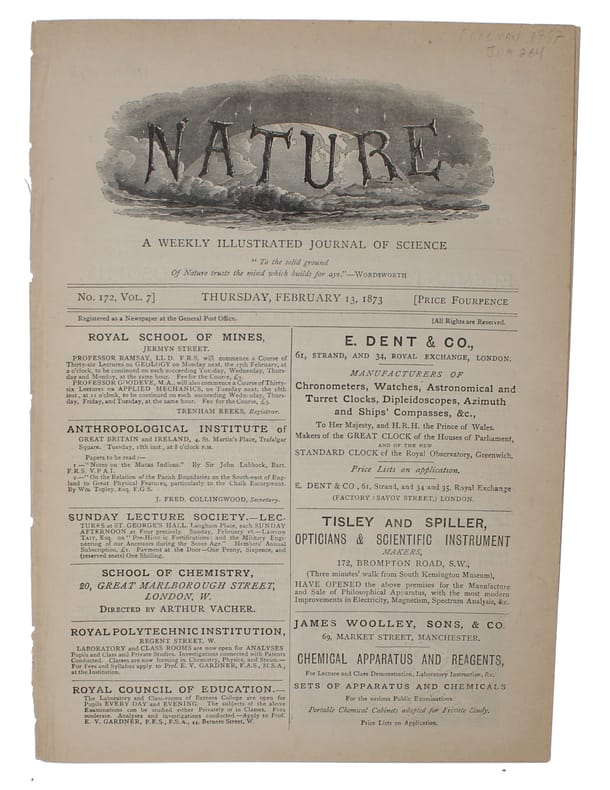
|
|
|
"DARWIN, CHARLES.
Jinsoron (i.e. Japanese ""On the Ancestor(s) of Man"", Translated by Kozu Senzaburo, original title: ""Descent of Man""). 3 vols. - [FIRST TRANSLATION OF DARWIN INTO JAPANESE]
Tokyo, Ichibe Yamanaka., Meiji 14. (1881). 8vo. 3 volumes, all in the contemporary (original?) yellow wrappers (Traditional Fukuro Toji binding/wrappers). Extremities with wear and with light soiling, promarily affecting vol. 1. Title in brush and ink to text-block foot. A few ex-ownership stamps. Folding plate with repair. A fine set. 46 ff" 70 ff. + 9 plates of which 1 is folded" 72 ff. ""Vol. I contains prefaces to 1st and 2d editions of Descent of man Nos 936 & 944"" vol. II contains chapter 1 and vol. III chapter 2. All published, intended to form 9 vols containing chapters 1-7 and 21."" (Darwin-Online).
Bookseller reference : 60016
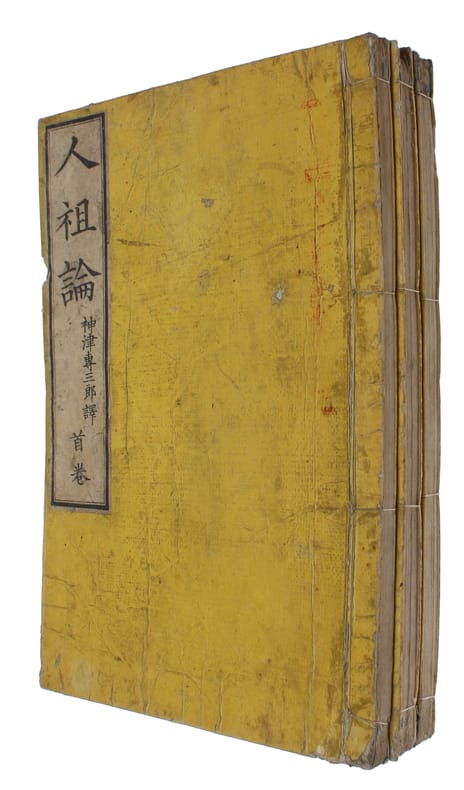
|
|
|
"DARWIN, CHARLES.
L'Origen de les especies. - [FIRST CATALAN TRANSLATION OF 'ORIGIN OF SPECIES']
Barcelona, Edicions 62, 1982 8vo. In the original printed wrappers. Light wear to extremities, spine with a few light stains. A nice and clean copy. 412 pp. The genealogical tree included in the pagionation on pp. 124-125.
Bookseller reference : 62054
|
|
|
"DARWIN, CHARLES.
La Descendance de l'Homme et la Sélection Sexuelle. [i.e. English: ""Descent of Man"", Translated by J. J. Moulinié ]. 2 vols. - [FIRST FRENCH TRANSLATION OF DARWIN'S 'DESCENT OF MAN']
Paris, C. Reinwald et Cie, 1872-1873. 8vo. 2 volumes uncut in publisher's original green full cloth with gilt lettering and ornamentation to spines and embossed front and back boards. A stamp to title-pages and very light wear to extremities, internally very fine, clean and fresh. XV, (1), 452, 24 [advertisements] pp."" (8), 494, (2) pp.
Bookseller reference : 54612
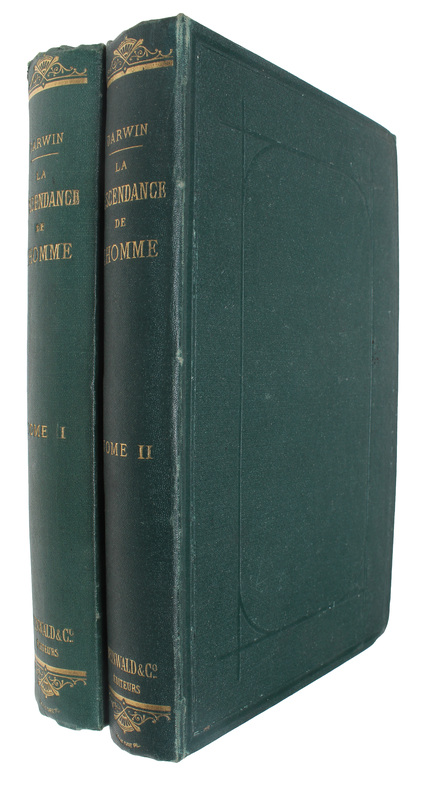
|
|
|
"DARWIN, CHARLES.
Menniskans Härledning och Könsurvalet. [English: ""The Descent of Man""). 2 vols. - [FIRST SWEDISH TRANSLATION OF ""THE DESCENT OF MAN""]
Stockholm, Albert Bonniers, 1872. 8vo. 2 volumes in one (as issued) contemporary half calf binding with gilt lettering to spine. A fine and clean copy. (Frontiespiece), (1), 314, (2) pp."" (4), XV, (1), 294, (6), 39 pp.
Bookseller reference : 52355
|
|
|
"DARWIN, CHARLES.
Nasekomoyadnye rasteniya [i.e. Russian: ""Insectivorous Plants""], [3 issues, all]. - [FIRST RUSSIAN TRANSLATION OF 'INSECTIVOROUS PLANTS' ]
Moscow, izdanie V. P. Plemânnikova, 1876. 8vo. 3 parts bound in 2 uniform contemporary full cloth bindings with blind stamped titles to spines. Some soiling to extremities and part of cloth around hinges worn of. Internally with occassional brownspotting. (4), 168, (2), 393, (1), VII, (2) pp. + 4 folded plates.
Bookseller reference : 60588
|
|
|
"DARWIN, CHARLES.
Naturwissenschaftliche Reisen nach den Inseln des grünen Vorgebirges, Sudamerika, dem Feuerlande, den Faltland-Inseln, Chiloe-Inseln, Galapagos-Inseln, Otaheiti, Neuholland, Neuseeland, Ban Diemen's Land, Keeling-Inseln, Mauritius, St. Helena, den Vz... - [FIRST TRANSLATION OF ANY OF DARWIN'S WORK]
Brunswick, F. Vieweg und Sohn, 1844. 8vo. 2 volumes bound in one contemporary half calf binding with gilt lettering to spine. Previous owner's stamp to front free end-paper. Light brownspotting throughout, especially to first and last leaves. XVI, 319, VIII, 301, (3) pp. + 1 folded map.
Bookseller reference : 54590
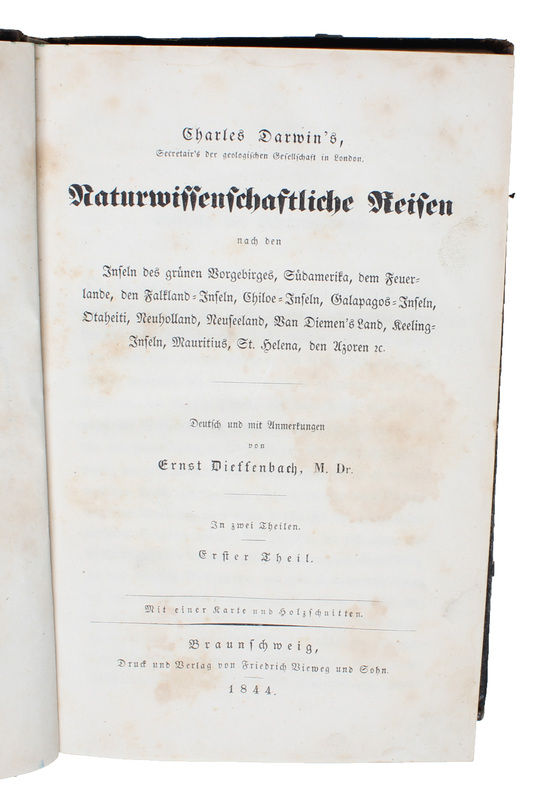
|
|
|
"DARWIN, CHARLES.
Notes on the Effects produced by the Ancient Glaciers of Caernarvonshire, and on the Boulders transported by Floating Ice.
London, University of London, 1842. 8vo. In contemporary half calf. In ""The London, Edinburgh, and Dublin Philosophical Magazine and Journal of Science"", Vol. XXI. July - December, entire volume offered. Spine with wear and lacking bits of the leather especially affecting front hinge. Leather brittle. Front hindge loose. Exlibris pasted on to pasted down front end-paper. Internally nice and clean. [Darwin's paper:] Pp. 180-88. [Entire volume: viii, 568 pp.].
Bookseller reference : 60134
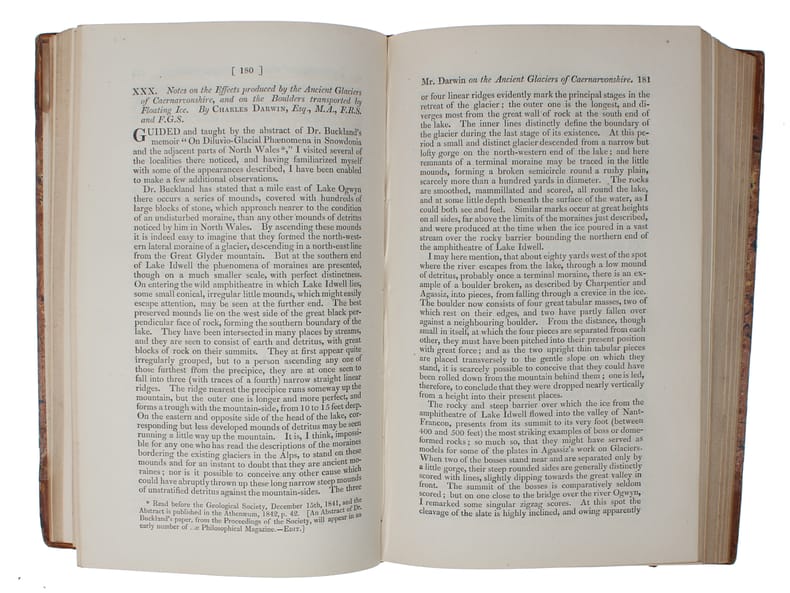
|
|
|
"DARWIN, CHARLES.
O Proischozhdenii Vodov... [Russian: On the Origin of Species]. Perevel c anglijskago [translated from English by] S.A. Rachinsky. - [""THE MOST IMPORTANT BIOLOGICAL BOOK EVER WRITTEN"" (FREEMAN)]
S.-Peterburg, 1864. 8vo. Bound in a beautiful half calf recent pastiche-binding with marbled papers over boards and elegant gilding to spine. End-papers renewed. Stamp to half-title, title-page and first leaf of text. First leaves evenly browned and dampstain to outer margin affecting last 50 ff. A few occassional brownspots throughout. XIV, 399, (1) pp. + 1 plate with genealogical tree (between pp. 92/93).
Bookseller reference : 60791
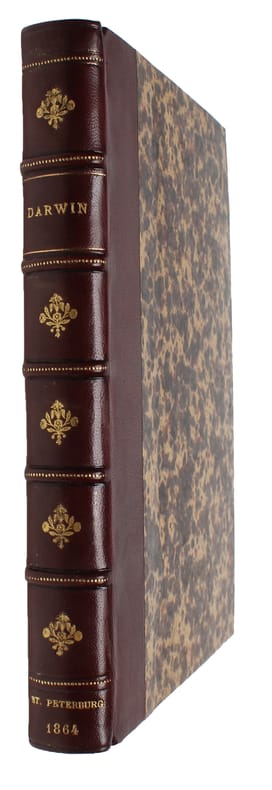
|
|
|
"DARWIN, CHARLES.
O Proischozhdenii Vodov... [Russian: On the Origin of Species]. Perevel c anglijskago [translated from English by] S.A. Rachinsky. - [""THE MOST IMPORTANT BIOLOGICAL BOOK EVER WRITTEN"" (FREEMAN)]
S.-Peterburg, 1864. 8vo. Bound in a beautiful recent pastiche-binding of brown half calf with marbled papers over boards and elegant gilding to spine. End-papers renewed. A few dampstains and a bit of brownspotting throughout. A nice copy. XIV, 399, (1) pp. + 1 plate.
Bookseller reference : 56000
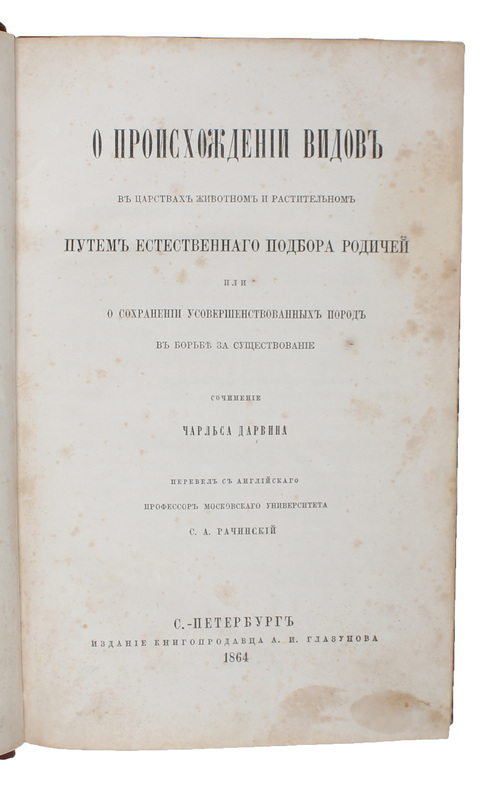
|
|